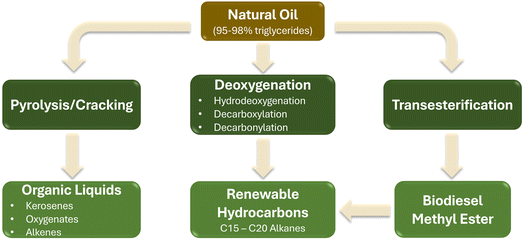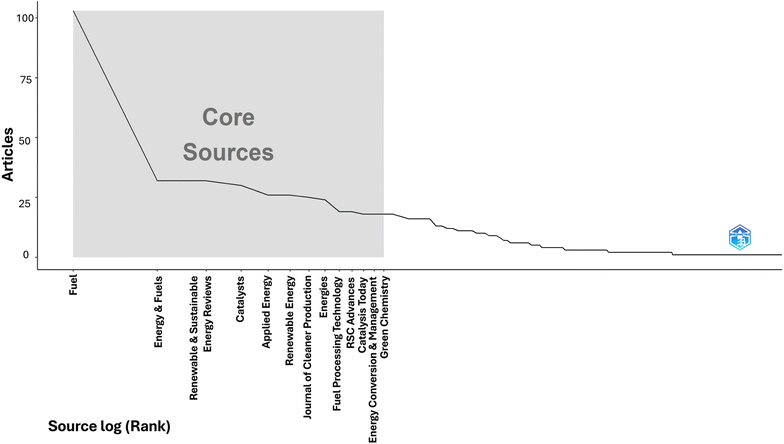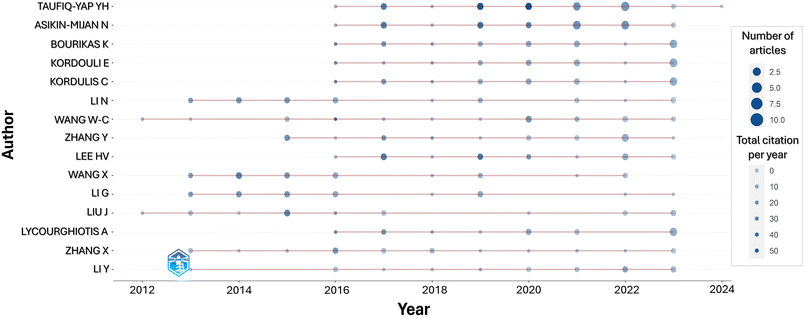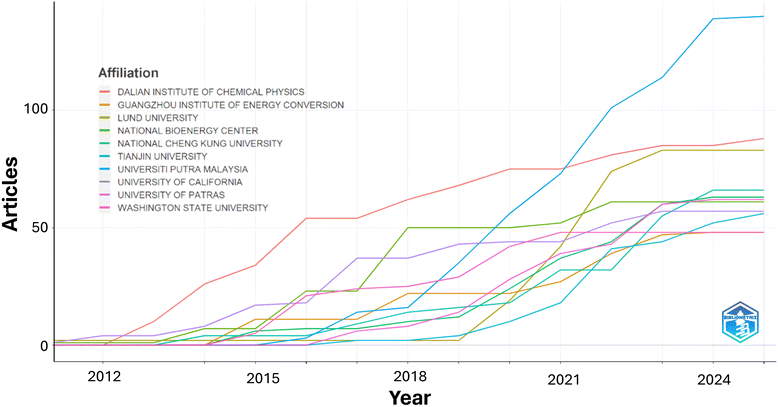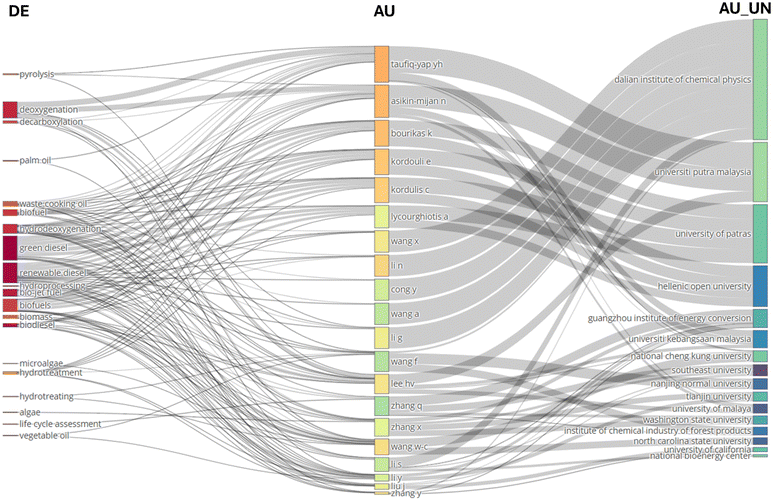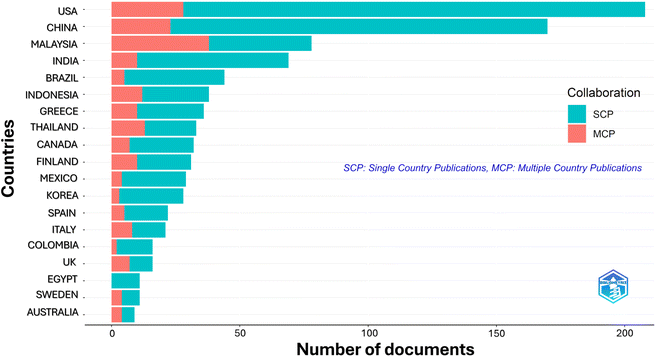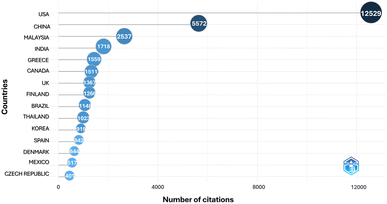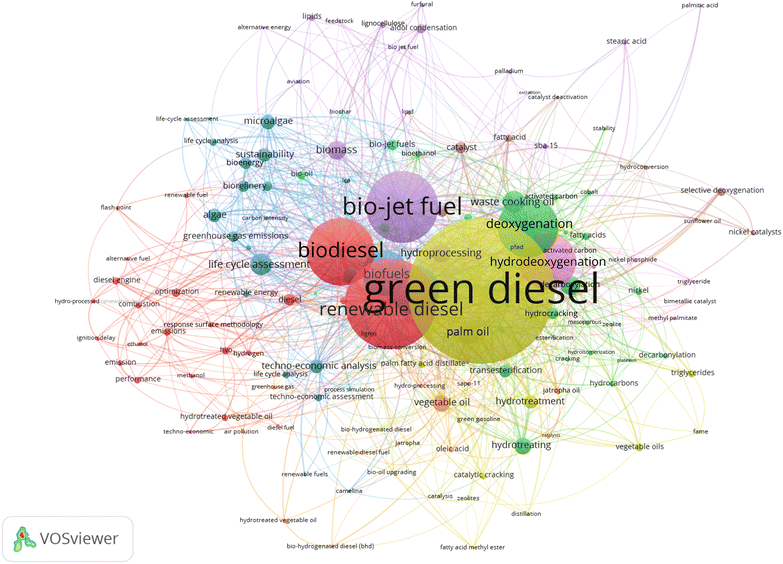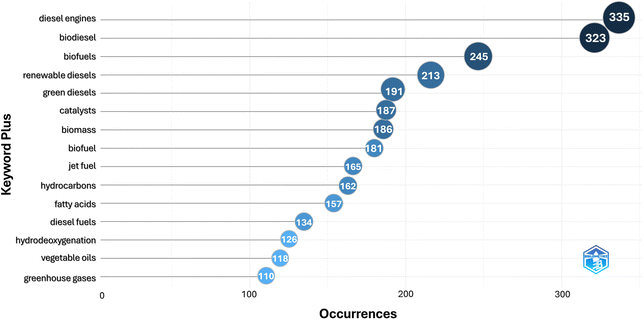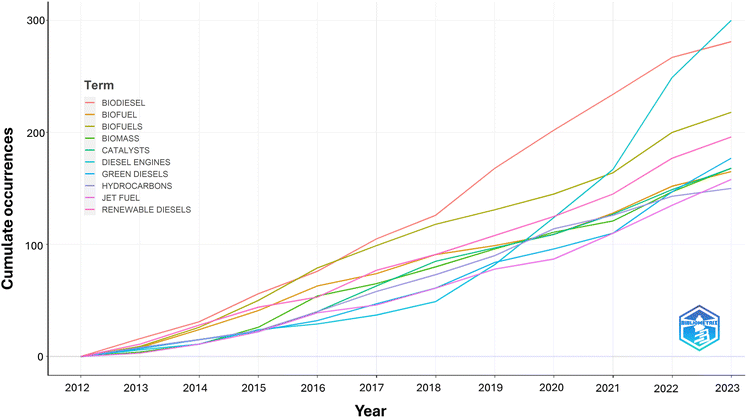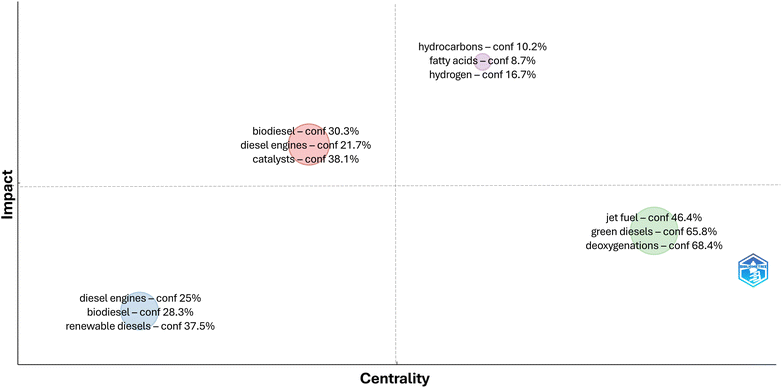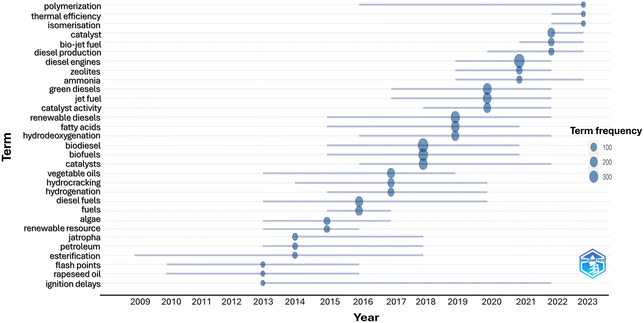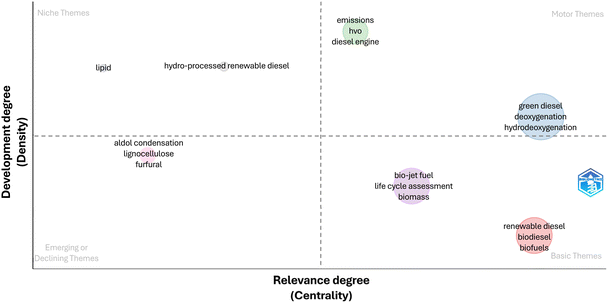 Open Access Article
Open Access ArticleAdvancements in green diesel production for energy sustainability: a comprehensive bibliometric analysis
Jeesica Hermayanti Pratama a,
Zeni Rahmawati
a,
Zeni Rahmawati a,
Alvin Rahmad Widyantoab,
Triyanda Gunawan
a,
Alvin Rahmad Widyantoab,
Triyanda Gunawan a,
Wan Nazwanie Wan Abdullah
a,
Wan Nazwanie Wan Abdullah c,
Nor Laili Azua Jamari
c,
Nor Laili Azua Jamari d,
Afan Hamzahe and
Hamzah Fansuri
d,
Afan Hamzahe and
Hamzah Fansuri *a
*a
aDepartment of Chemistry, Faculty of Science and Data Analytics, Institut Teknologi Sepuluh Nopember, Surabaya 60111, Indonesia. E-mail: h.fansuri@its.ac.id
bDepartment of Applied Chemistry, Shibaura Institute of Technology, 3-7-5 Toyosu, Koto-ku, Tokyo 135-8548, Japan
cSchool of Chemical Science, Universiti Sains Malaysia, 11800 Penang, Malaysia
dDepartment of Chemistry & Biology, Centre for Defence Foundation Studies, National Defence University of Malaysia, Kem Sungai Besi, Kuala Lumpur 57000, Malaysia
eDepartment of Industrial Chemical Engineering, Faculty of Vocational, Institut Teknologi Sepuluh Nopember, Surabaya 60111, Indonesia
First published on 12th November 2024
Abstract
Green diesel as a second-generation biofuel has received enormous attention owing to the huge demand for renewable fuel for addressing the net zero target in 2050. This study examines the development of green diesel research through a bibliometric analysis. The state-of-the-art green diesel research is studied based upon 1285 documents (1153 articles and 132 reviews) retrieved from the Scopus database related to the used keywords. The analysis focused on three categories: publication outcomes, most cited papers, and research area identification. The VOSviewer and RStudio (bibliometrix) were applied to analyse the data, rationalized within the framework of author, affiliation, country, citation analysis, cross-dimensional keyword analysis, research streams, and research gaps. The general result of the study highlighted a continuous incline in article numbers classified into three stages: initiation, exploration, and elevation. Those articles were mainly published in bioenergy-themed journals, including Fuel, Energy & Fuels, and Renewable and Sustainable Energy Reviews. Taufiq-Yap Yun Hin is the highest contributor with 41 articles, and Fuel published 110 articles. The rapid growth of green diesel was also inferred by the extensive spread of research maps worldwide. Amid those swift developments, the state of the art on green diesel through bibliometric analysis is not available to the best of our knowledge as far. Subsequently, this review aims to display the state of the art, research gap, and future forecast of green diesel research.
1 Introduction
The awareness of climate change as an adverse effect of fossil fuel combustion has encouraged the development of alternative fuels derived from renewable sources such as biomass. The conversion of biomass to biofuel has become the center of interest in recent years since biomass displays a promising potential in chemical structure similarity to fossil fuel. Biodiesel (fatty acid methyl ester) has become the most produced biofuel owing to its ease of production, low-cost process, and excellent CO2 and NOx emission. According to the Indonesia Energy Outlook 2023, biodiesel consumption is growing at the fastest rate, with an average of 7.4% per year, indicating a high demand for this type of biofuel. Amidst those superiorities, biodiesel exhibits several drawbacks, including lower energy content and high oxygen content, leading to incomplete combustion and engine blockage.1,2 Biodiesel also displays high viscosity and degrades during storage due to polymerization. These challenges can be addressed by producing drop-in biofuels with enhanced fuel properties. Drop-in biofuels consist of biohydrocarbons with carbon chain lengths similar to those found in fossil fuels. These biofuels are especially appealing as alternatives to jet fuel and petroleum diesel, commonly referred to as bio-jet fuel (or bio-kerosene) and green diesel.3Green diesel has emerged as the most rapidly developed biofuel worldwide due to its structure being identical to fossil fuel. Unlike biodiesel, green diesel can be directly applied to the engine without mixing with fossil fuel or engine modification.4,5 Fortunately, biodiesel with fatty acid methyl ester can be upgraded through catalytic deoxygenation involving hydrogenation, decarboxylation, and decarbonylation reaction pathways. These processes will remove the oxygen and produce renewable alkanes with superior properties.
The main advantage of green diesel centers upon its excellent properties over biodiesel. Green diesel fulfills ASTM standards (D-97, D-973, D-1298, D4294-03, and D-613)6–9 for covering flash point, energy content, cetane number, viscosity, density, and oxygen, sulfur, and water content, respectively.10,11 Green diesel also provides higher energy content and low oxygen content, allowing complete combustion without engine modification. Moreover, green diesel supports the United Nations' Sustainable Development Goals (SDGs) for affordable and clean energy (SDG 7) and climate action (SDG 13), as well as the International Civil Airlines Association (ICAO) and International Air Transport Association (IATA) targets for net zero emissions by 2050. These superiorities highlight the beneficial rapid development of green diesel up to industrial scale.
The swift expansion of green diesel is reflected in the academic studies examining various aspect of its production process, including catalyst design, reaction conditions, and economic and environmental assessments. The growth trend can be visualized through bibliometric analysis, which highlights the importance, relevance, and scientific knowledge of green diesel. Bibliometric analysis also demonstrates specific historical data to the future forecast. The essential significance of this study lies in its mathematical and statistical methods covering all quantitative analysis of all fields of knowledge.12 Bibliometric has emerged as a powerful quantitative analysis for evaluating the progress of a specific research field, thus gaining justified attention.13 This analysis effectively identifies technological bottlenecks and research gaps over a rapid accumulation of the published literature of a particular study.14
Bibliometric analysis has been extensively applied across various domains of renewable energy research, including biodiesel production,14–16 the study of sustainable economies,17 and green hydrogen.12,13 However, to the best of our knowledge, no comprehensive bibliometric analysis dedicated solely to green diesel research exists. While previous studies have briefly referenced bibliometric insights in the context of green diesel, these discussions have been limited in scope, focusing narrowly on article counts, journal origins, and citation networks. This gap in the literature leaves a significant void in understanding the broader research landscape, scholarly trends, and collaborative networks specific to green diesel.
With the increasing global focus on sustainable energy and rapid advancements in renewable energy technologies, a focused bibliometric analysis of green diesel research is both timely and essential. This study fills that gap by offering a detailed overview of green diesel research developments, including trends in publications, citation analysis, authorship, and geographical spread. Furthermore, it identifies key gaps in the existing research and outlines future research opportunities, making it a valuable resource for both scholars and industry professionals.
This study contributes to the biofuel literature in three key ways. First, it provides an in-depth bibliometric analysis of green diesel research, examining critical indicators such as publication output, citation networks, and research collaborations. Second, it enhances the current literature on green diesel production by offering a comprehensive assessment of scholarly engagement with the field. Finally, it identifies existing research gaps and proposes directions for future inquiry, which are vital for accelerating the global adoption of green diesel and informing renewable energy policymakers.
This work is organized into five sections, beginning with the introduction. Section two outlines the methodology, detailing data collection, analyses, and visualization techniques. Section three reviews the state-of-the-art developments in green diesel production. Section four presents the bibliometric analysis findings, including publication outcomes, contributions from authors, institutions, and countries, as well as the most frequently cited articles and common keywords identified in the research. Finally, section five discusses the key research streams, highlights gaps in the existing literature, and offers projections for future research and development in the field of green diesel.
2 Methodology
2.1. Data collection
The literature review encompassed published articles, reports, case studies, and online information from a range of governmental and non-governmental organizations. Data was electronically sourced from multiple databases, including Google Scholar, ScienceDirect, Springer, the Royal Society of Chemistry, ACS, and De Gruyter, etc. A systematic search was conducted using different configurations of keywords related to the subject area of the review. Relevant information was extracted from selected articles, compiled, and presented to provide a comprehensive overview of the current state of green diesel research.The acquisition of literature data for bibliometric analysis is focused on the Scopus database (https://www.scopus.com/) due to its high-quality criteria of indexation inclusivity.18 The Scopus database is known for its comprehensive collection of interdisciplinary academic papers from reputable scientific journals.19,20 The database encompasses diverse scientific disciplines, positioning it as a prominent repository for citations and abstracts. Scopus is a prominent and extensively utilized search database among researchers and scholars. The Scopus database was collected according to search inquiry TITLE-ABS-KEY (“green diesel” OR “renewable diesel” OR “bio-jet” OR “biohydrofined diesel” OR “biohydrocarbon diesel”) AND (LIMIT-TO (DOCTYPE, “ar”) OR LIMIT-TO (DOCTYPE, “re”)), taking into account of the relevance of the title, abstract, author keywords, and scientific information. Afterward, publication data was selected based on the initial criteria of (i) publication without year restrictions, (ii) publication written in English, and (iii) publication being an article or review document. Database information was collected until October 4, 2024. The final search yielded 1285 articles related to renewable diesel and its similar terms.
2.2. Data analyses and visualization
VOSviewer software version 1.6.19 (https://www.vosviewer.com/) was used to visualize bibliometric maps illustrating scientific research's structural and dynamic aspects.21 This study employs two types of bibliometric analysis techniques: data mapping and component analysis. Data mapping focuses on the relationship between related research constituents, while research component analysis considers the contribution of research constituents to developing the selected topic. Detailed visualization was provided by the bibliometrix app supplied by Rstudio version 2024.09.0 build 375.22 The data extracted from Scopus in. csv format was imported into biblioshiny for in-depth analysis. Biblioshiny, an open-source visualization tool based on RStudio, offers several advantages, including statistical analysis, index computation, network analysis, and the creation of knowledge maps. It enables data import from the Web of Science (WoS) and Scopus databases. Aria and other experts, as the developers, have introduced the software's main function module. Running “>bibliometrix::biblioshiny()” initiates the biblioshiny program. In bibliometrix, the necessary documents and data from the primary database were incorporated to generate a data matrix, which facilitated the execution of scientific cooperation analysis, co-cited reference, and coupling functions. The structured and quantitative analysis of literature data displays the evolution of specific research fields, enhances understanding of historical and contemporary knowledge bases, tracks emerging themes, forecasts future trends, and informs the strategic direction of ongoing research initiatives.23VOSviewer's emphasis on co-citation and keyword analysis makes it ideal for identifying core research areas and the intellectual structure of a field. Biblioshiny, with its broad bibliometric capabilities, excels in evaluating productivity, citation dynamics, and emerging trends. Combining these tools offers a comprehensive approach: biblioshiny provides detailed metrics and thematic analysis, while VOSviewer delivers intuitive visualizations. This integration is particularly effective for our study on publication mapping and trend analysis, leveraging the strengths of both tools for a better understanding of the research landscape. The detailed steps of bibliometric analysis and science mapping are shown in Fig. 1.
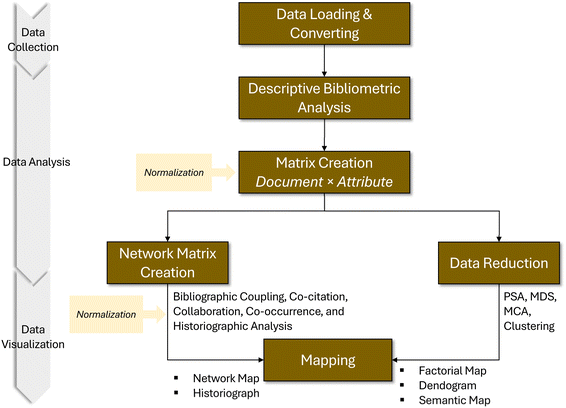 | ||
| Fig. 1 The suggested science mapping methodology and bibliometrix by Aria et al.22 | ||
3 State of the art: green diesel production
Fossil fuels substitution in the transportation industry has been facing an immense challenge to compromise the energy density and fuel properties. Biofuel has emerged as the most promising alternative owing to its similar chemical structure, stable supply of feedstock, and effective CO2 reduction. Vegetable oil has been widely investigated as a promising feedstock of biofuel. The direct use of biofuels is constrained by their high viscosity, low volatility, and composition of triglycerides with high molecular weights.10 Many studies have reported the successful upgrade of natural oil to several types of biofuel.There are three main pathways to produce biofuel from natural oil containing triglycerides,2 as illustrated in Fig. 2. Firstly, thermal cracking or pyrolysis of vegetable oil in the presence or absence of a catalyst. Catalytic cracking was conducted at 300–500 °C with acid catalysts such as zeolites, Al2O3, MgO, CaO, and Cu.24,25 To lower the energy requirement for pyrolysis process, many researchers prefer the microwave-assisted pyrolysis method. This method offers advantages over conventional pyrolysis by significantly reducing processing times and increasing bio-oil yields through more efficient and uniform heating of biomass.26 These processes produce a mixture of hydrocarbons of shorter chain lengths with characteristics similar to fossil fuels.10 However, catalytic cracking produces a wide range and low selectivity of products. This is because the catalytic cracking atmosphere allows several side reactions, such as cyclization or aromatization. The side reactions resulted in oxygenates as other product.10,24,27
Secondly, the transesterification of triglycerides with alcohol in the presence of base or acid catalysts yields biodiesel or fatty acid mathyl ester (FAME). Biodiesel exhibits many advantages, such as a very simple procedure under mild conditions, non-toxicity, and biodegradability. Furthermore, the exhaust gases from biodiesel combustion are free if SOx and contain relatively low levels of CO,11 with a cetane number ranging between 49 and 60,28 indicating favorable combustion characteristics. However, biodiesel exhibits drawbacks regarding storage, a lower oxidation and thermal stability, high oxygen content, elevated viscosity, and a lower heating value that are unable to be applied directly to common combustion engines and must be mixed with fossil fuel.2,10,29
The third method is the deoxygenation of vegetable oil, a very promising pathway that removes oxygen from triglyceride in the presence of a catalyst. This process results in alkanes in the range of petrodiesel, usually called renewable diesel or green diesel. This way promises the answer to problems associated with biodiesel as renewable diesel can maintain its properties during prolonged storage without degradation.10 Renewable diesel possesses a higher cetane number and exhibits greater biodegradability.30 Moreover, renewable diesel shows superior fuel properties such as less CO, NOx, hydrocarbon (HC), and sulfur emissions.6 Deoxygenation of vegetable oil is limited by free fatty acid contained in the feedstock, a problem hindering the production of biodiesel by saponification reaction.
In comparison to petrodiesel and biodiesel, green diesel exhibits enhanced physical properties, such as cloud point, flash point, viscosity, and lubricity, along with higher energy density and cetane number (CN). Additionally, green diesel has been evaluated as a promising renewable fuel alternative9 that can be applied directly to engines without requiring engine modification.4,5 Several key aspects of green diesel research and development include production technologies, feedstock, catalyst design, fuel properties and performance, and environmental elements. Table 1 shows some deoxygenation reaction conditions in green diesel production.
| Catalyst | Feedstock | Reaction condition | Product |
|---|---|---|---|
| Pd/C (ref. 31) | Crude palm oil | T = 350 °C, P = 40 bar, t = 2 h | Conversion = 98%, C15–C18 n-alkane 180 g L−1 |
| Fixed-bed reactor | |||
| Pt/Al2O3 (ref. 32) | Palm oil | T = 380 °C, P = 40 bar, WHSV = 2 h−1 | Conversion = 100%, yield C15 + C17 = 68%, yield C16 + C18 = 10.2% |
| Trickle bed reactor | |||
| Pt/ZrO2 (ref. 33) | Oleic acid | T = 260 °C, P = 20 bar H2, t = 5 h | Conversion = 55%, selectivity C17 = 58.2%, selectivity C18 = 37.1% |
| Batch reactor | |||
| Ru/TiO2 (ref. 34) | Ethyl stearate | T = 220 °C, P = 10 bar H2, t = 6 h | Conversion = 98%, selectivity C17 = 64%, selectivity C18 = 30% |
| Batch reactor | |||
| Co/ZrO2 (ref. 35) | Ethyl palmitate | T = 240 °C, P = 20 bar H2, t = 8 h | Conversion = 100%, selectivity C15 = 56%, selectivity C16 = 12% |
| Batch reactor | |||
| Co/Al2O3 (ref. 36) | Palm oil | T = 330 °C, P = 50 bar H2 | Conversion = 100%, selectivity C17 = 34%, selectivity C18 = 50% |
| Continuous-flow trickle bed reactor | |||
| CoW/SiO2–Al2O3 (ref. 37) | Chinese wood oil | T = 350 °C, N2, t = 2 h | Hydrocarbon yield = 69%, selectivity jet fuel = 60% |
| Semi-batch reactor | |||
| Ni/γ-Al2O3 (ref. 38) | Rubber seed oil | T = 350 °C, P = 35 bar H2 | Conversion = 99.99%, diesel-range hydrocarbon yield = 55.10 wt% |
| Fixed-bed reactor | |||
| NiMo/γ-Al2O3 (ref. 39) | FAME | T = 380 °C, P = 50 bar H2 | Conversion = 100%, selectivity C15–C18 = 92.45% |
| Fixed-bed reactor | |||
| Ni/SAPO-11 (ref. 40) | Stearic acid | T = 290 °C, P = 40 bar, t = 3 h | Conversion >97%, selectivity C15–C18 > 91% |
| Batch reactor | |||
| Ni/CeO2–Al2O3 (ref. 41) | Methyl laurate | T = 300 °C, P = 30 bar (10% H2/N2), t = 4 h | Conversion = 100%, selectivity C11 = 98%, selectivity C12 = 2% |
| Semi-batch reactor | |||
| Ni/Al2O3 (ref. 36) | Palm oil | T = 330 °C, P = 50 bar H2 | Conversion = 100%, selectivity C17 = 80%, selectivity C18 = 2% |
| Continuous-flow trickle bed reactor | |||
| Mo/γ-Al2O3 (ref. 42) | Oleic acid | T = 300 °C, P = 40 bar H2, t = 2 h | Conversion = 91.39%, selectivity C13–C18 = 42.22% |
| Batch reactor | |||
| Mo/AC (ref. 43) | Palm fatty acid distillate | T = 350 °C, N2, t = 1 h | Hydrocarbon yield = 41%, selectivity C15 = 39%, C8–C20 distribution = 59% |
| Semi-batch reactor |
Green diesel production by deoxygenation (DO) process involves several reaction pathways simultaneously or individually, including hydrodeoxygenation (HDO), decarboxylation (DCO2), and decarbonylation (DCO).44 The deoxygenation reaction is a thermal process of alkane production by removing hydrogen, oxygen, and carbon atoms from fatty biomass by releasing CO2, CO, or H2O.45 The HDO reaction removes oxygen in the form of water molecules, resulting in alkanes with an even number of carbon atoms (eqn (1)). The DCO reaction produces odd-numbered alkane molecules accompanied by carbon monoxide and water as in eqn (2). Meanwhile, the DCO2 reaction produces alkane molecules along with carbon dioxide. This reaction is similar to DCO without water molecules, as stated in eqn (3). Alkanes produced through DCO or DCO2 contain one fewer carbon atom than the original fatty acids.46 The use of a hydrogen atmosphere can reduce catalyst deactivation rates compared to inert atmospheres, but its practical feasibility in industrial applications is limited due to high operational costs. While the HDO reaction pathway is the most efficient, it needs a high-pressure hydrogen which increase cost production.47 DCO requires less hydrogen than HDO, and DCO2 does not require hydrogen at all.48,49 However, both DCO and DCO2 involve higher temperatures to break C–C bonds.44
| CnH2nO2 + 3H2 → CnH2n+2 + 2H2O, ΔH < 0 | (1) |
| CnH2nO2 + H2 → Cn−1H2n + CO + H2O, ΔH > 0 | (2) |
| CnH2nO2 → Cn−1H2n + CO2, ΔH > 0 | (3) |
As indicated by the reactions above, HDO is an exothermic process, whereas DCO and DCO2 are endothermic. Deoxygenation (DO) processes generally operate within a temperature range of 280–450 °C and a pressure of 20–50 bar, depending on factors such as the feedstock, catalyst, reactor design, and operational conditions.50 At higher temperatures, hydrocracking can occur, producing lighter alkanes.51 Above 350 °C, the endothermic DCO and DCO2 reactions52,53 are thermodynamically favored over the exothermic HDO, altering the hydrocarbon profile. Conversely, lower temperatures favor HDO and can trigger secondary reactions like methanation, water–gas shift, and the Boudouard reaction.49 As the DO reaction is an energy-intensification process, green chemistry principles require the use of catalysts to reduce energy requirements.54 Catalytic research is an important part of the advancement of green diesel fuels. Recent research has focused on developing more effective and efficient catalysts for this process.55 The optimal conditions for this process should enable the production of green diesel with a high cetane number while minimizing coke formation.56 The advancement of both homogeneous and heterogeneous catalysts with robust chemical stability, excellent catalytic activity, and high hydrocarbon selectivity within the diesel range is crucial for the efficiency of DO reactions.57 Homogeneous catalysts, such as MnCl2, ZnCl2, CoCl2, CuSO4, MgSO4, NaOH, and KOH, have the drawback of being difficult to recover at the end of the reaction, which limits their potential for reuse.58 In general, homogeneous catalysts are employed in DO reactions for fine chemicals production, such as alkenes, benzene, phenols, furans, and acrolein, which are directly derived from biomass.59 Conversely, heterogeneous catalysts are predominantly used in green diesel production.
Supported metal catalysts are the most commonly applied catalyst in green diesel production. The effectiveness of these catalysts relies on the metal active sites and the properties of the support material. Key factors influencing catalyst performance include metal dispersion, particle size, surface area, porosity, metal-support interactions, and acidity. A high metal particles dispersion on the support is essential for enhancing catalytic activity, as highly dispersed metal particles offer a greater number of active sites for the reaction, thereby increasing overall efficiency.51,60,61 The metal area of the catalyst is also important in determining its activity. A larger metal area can result in increased catalytic activity because it provides more active sites for the reaction.60 The particle size of the catalyst influences the selectivity of deoxygenation reactions. Smaller catalyst particles promote methane formation and selectivity to C2 compounds, whereas larger catalyst particles promote hydrocarbon conversion, including dehydrogenation and reforming reactions. The porosity of the support material influences the accessibility of reactants to the active sites of the catalyst. A higher porosity can improve catalytic activity by facilitating the diffusion of reactants and products.51,60 The interaction between the metal catalyst and the support material is critical for governing the stability and dispersion of the metal on the support. Strong metal-support interaction (SMSI) plays a crucial role in influencing both the performance and stability of catalysts.51,60,61 The catalyst's acidity can influence its effectiveness in deoxygenation reactions. Ameen et al.38 reported that increasing the metal loading on the catalyst enhances its acidity, which in turn leads to higher catalytic activity in the HDO of rubber seed oil. The conversion of triglycerides reached 99.9%.
Catalysts with metal active sites will influence the efficiency DO reaction to produce green diesel. The primary group of metal catalysts commonly employed in green diesel production consists of noble metals, such as palladium (Pd), platinum (Pt), and rhodium (Rh). These metals are favored due to their high catalytic activity.62–64 Although precious metal catalysts have high activity for producing green diesel, there are economic limitations due to high production costs. The second group of metal catalysts, bimetallic catalysts,65–67 can enhance both activity and stability through synergistic interactions between two metals.68 The third group includes metal oxide compound catalysts, as well as69,70 carbide,71,72 sulfide,42,73,74 phosphide,71,75 and nitride.75,76 The fourth group features non-noble metal catalysts, such as nickel,38,69 molybdenum,77,78 manganese,48,79 copper,48,80 tungsten,81,82 cobalt,83,84 and zinc,85,86 which offer a more cost-effective alternative.
Catalysts composed of metal oxides, sulfides, carbides, phosphides, and nitrides have shown significant effectiveness in removing oxygen and selectively producing diesel-range alkanes. However, the more complicated catalyst preparation and the transformation of the active phase shorten the catalyst's lifetime. Consequently, single metal and sulfur-free catalysts continue to garner considerable interest for DO reactions, owing to their high reactivity at low temperatures, the absence of sulfur contamination in the liquid product, and reduced hydrogen requirements.36
Some of the advantages of monometallic catalysts include (i) simple catalyst design because it only involves one metal so that the synthesis, characterization, and analysis processes are more accessible to carry out on specific catalyst properties and performance, (ii) show higher activity on specific reactions compared to bimetallic catalysts, (iii) lower production costs so it better supports large-scale industrial applications (commercialization), and (iv) ease of catalyst optimization by optimizing reaction conditions and reaction parameters to achieve targeted selectivity and performance.87
Hydrodeoxygenation (HDO) process requires high pressure hydrogen that perceived as the most drawback associated with high cost and energy requirement. Other challenges include low feasibility due to expensive infrastructures and catalyst deactivation caused by coke formation.
In terms of fuel properties and performance, green diesel is similar to petroleum-based diesel and it is also compatible with compression ignition internal combustion engines.28,49 Research has demonstrated that green diesel exhibits enhanced fuel economy and lower emissions than conventional diesel.88 As a renewable diesel fuel, green diesel can positively impact environmental aspects, namely reducing greenhouse gas emissions.49,88 However, environmental consequences may also ensue as an outcome of the production procedure, and assessments of sustainability hold significant importance in the realm of green diesel research. Overall, the primary aim of research and development in the field of green diesel is to optimize the fuel characteristics and overall performance of the end product while simultaneously enhancing the manufacturing process's efficiency and sustainability.
Neste, the leading producer of renewable diesel on a global scale, has demonstrated one of the Bio-to-Liquid (BTL) process's achievements. Neste has an approximate annual production capacity of 3 million tonnes.89 Neste developed the NExBTL (Next Generation Bio-to-Liquid) process, which can transform waste oil and natural oil into green diesel and aviation biofuel. The configurable nature of the raw materials includes animal fat, palm oil, palm oil fatty acids, rapeseed oil, jatropha, sunflower oil, soybean, and cottonseed. Based on conventional purification technology, the NExBTL process consists of HDO and isomerization in two stages. This integration allows for efficient operation within pre-existing purification systems, resulting in shorter equipment start-up times and decreased operating costs.90,91 Feedstock availability, production costs, and efficiency may influence the choice of technology. Feedstocks derived from lignocellulosic biomass, waste vegetable oil, and other oleaginous biomasses are successfully utilized in green diesel production.28,49,88 Arun et al.92 state that utilizing renewable bio-based feedstocks as a fuel source offers various environmental, social, and economic advantages, such as consistent access to raw materials, decreased carbon footprint, and a thriving agricultural economy. Feedstock variability also presents a major challenge in green diesel production, as the properties of biomass, such as vegetable oils, animal fats, and waste oils, significantly impact the efficiency and cost of the process. Feedstocks with high oxygen, sulfur, or nitrogen content require more intensive deoxygenation, increasing hydrogen consumption and operational costs. Additionally, contaminants in low-quality feedstocks can lead to catalyst poisoning and deactivation, further complicating the process. To address these challenges, research is focused on improving catalyst design for greater tolerance to impurities and optimizing reaction pathways, such as DCO2, to reduce hydrogen demand. Advances in feedstock pretreatment, along with the development of more robust catalysts, aim to enhance the efficiency and scalability of green diesel production while minimizing costs.
As explained above, prior research on green diesel has resulted in various advancements. Therefore, the next challenge is to enhance green diesel production technology for commercialization while maintaining environmental ethics and utilizing renewable energy sources. This involves not only improving the efficiency of the production process but also ensuring that the technology is scalable and economically viable. It is crucial to develop methods that can convert a wide range of biomass into green diesel, thereby reducing dependency on fossil fuels. Furthermore, the production process should be designed to minimize waste and emissions, aligning with the principles of green chemistry. Lastly, the use of renewable energy sources in the production process, such as solar or wind energy, can further reduce the carbon footprint of green diesel. These advancements will pave the way for a sustainable and eco-friendly future in the energy sector.
4 Results and discussion
4.1 Bibliometric analysis
Bibliometric analysis examines global research trends within a specific field or topic by utilizing data from academic literature databases. Rather than providing a comprehensive review, it focuses on recent developments, challenges, research hotspots, and future prospects related to a particular subject. The analysis involves several key criteria, such as data sources, publication outputs, co-authorship networks, affiliated countries, and co-occurrences of keywords used by authors.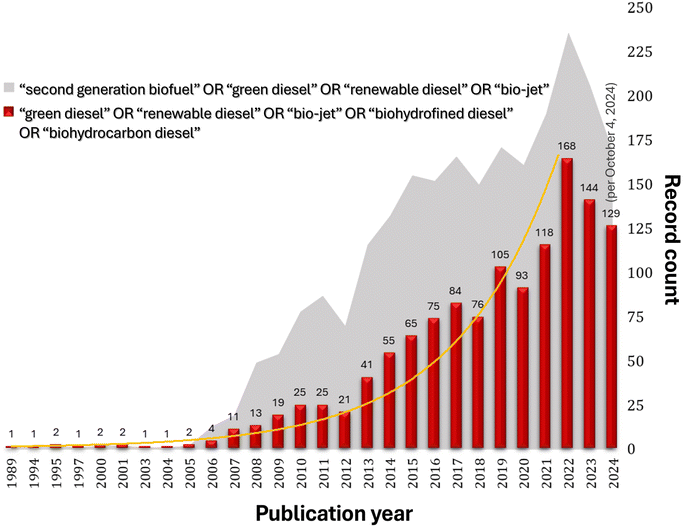 | ||
| Fig. 3 Annual publications include terms from 1989 to October 2024 (Source: Authors' clarification based on Scopus data). | ||
Based on the number of articles, we classify the development of green diesel into three stages: initial, exploration, and elevation. The initial stage was implied by a stagnant meager number of articles in the span of 1989 to 2006. Most of the article is centered around the interest in renewable energy, such as combustion processes,94–96 gasification,97–100 fermentation or biochemical transformation,101–103 and chemical transformation via catalytic processes.104–106 The annual number of green diesel articles significantly improved up to 114 publications in the second stage (2007 to 2012). Beyond that point, research on green diesel elevated to the next level with a dramatic incline in the number of articles published. A slight decrease occurred in 2020, presumably due to the indirect impact of the Covid-19 pandemic. After that, the publication amount continues to increase. Until early of the tenth month of 2024, research related to green diesel is still being developed, especially the exploration of catalysts in catalytic deoxygenation reactions and the use of biomass as an alternative biofuel. This upward trend is projected to continue in line with the clean energy goal planned for 2030. Apart from the number of documents, various journals have published articles related to green diesel, which also conveyed the rapid development in recent years. Based on the data obtained from the Scopus database, the predominant form of publication was articles, comprising 85% of the total publications. Review articles accounted for the remaining 15% of the publication. This finding calls for additional review studies of green diesel in the biofuel and renewable energy sector.
The article data analyzed were all published in internationally accredited journals covering specific subject areas. Fig. 4 presents the top ten subject topic areas, ranked according to the number of published articles in each field. Numerous scientific papers on green diesel have been published in various journals focusing on energy, chemical engineering, chemistry, environmental science, and engineering.
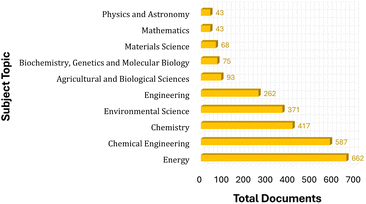 | ||
| Fig. 4 Distribution of the subject topic of all publications (Source: Authors' clarification based on Scopus data). | ||
The total publications were distributed throughout 159 journals, displaying a wide range of perspectives on studies related to green diesel. Moreover, research associated with green diesel embraces a variety of fields, such as agriculture, biology, materials science, mathematics, and physics. Hence, the studies of green diesel are identifiable by its multidisciplinary aspect. Green diesel development research can expand into a variety of fields. For example, catalyst material development and reaction optimization, feedstock availability in the supply chain, technology implementation mechanisms, product quality assessment, and product downstreaming to consumers. All sectors require distinct scientific perspectives that can complement one another.
To be precise, top journals and associated information are listed in Table 2. It mentions the top 15 most frequent scientific journals, covering 35.26% of the total available publications. Elsevier became the key player in green diesel publishing, with 80% of total publications. Fuel published the highest number of green diesel-related articles with 110 papers (8.56%) owing to the most suit scope and high reputation with an impact factor of 6.70 as well as 4255 citations. Even though the Renewable and Sustainable Energy Review journal has a lower number of publications (33 articles), this journal has 3705 citations, which can be attributed to the high IF and h-index of the journal as evidence of a high influence journal. On the other hand, Energy & Fuels (USA), Catalysts (Switzerland), and Renewable Energy (UK) are included in the top 5 journals, but they still need more citations. All of the listed journals exhibit similar scopes, e.g., renewable fuel, green technology, biomass conversion catalyst, environmental aspects, and energy management. The readership of these journals includes researchers and policymakers that correlated with materials engineering, energy, and management fields. These findings enable readers to identify suitable journals for publishing their works.
| No | Journal name (origin) | TP | Pr (%) | TC | IF | SJR 2023 | CS 2023 | H-index |
|---|---|---|---|---|---|---|---|---|
| a TP = total publications; Pr = percentage; TC = total citations; IF = impact factor; SJR = SCImago journal rank; CS CiteScore; NL = Netherlands; CH = Switzerland; UK = United Kingdom; USA = United States of America. Source: authors' clarification based on Scopus database (per October 4, 2024). | ||||||||
| 1 | Fuel (NL) | 110 | 8.56 | 4255 | 6.70 | 1.45 | 12.80 | 256 |
| 2 | Energy & Fuels (USA) | 33 | 2.57 | 951 | 5.20 | 1.02 | 9.20 | 221 |
| 3 | Renewable and Sustainable Energy Reviews (UK) | 33 | 2.57 | 3705 | 16.30 | 3.60 | 31.20 | 421 |
| 4 | Catalysts (CH) | 30 | 2.33 | 650 | 3.80 | 0.69 | 6.80 | 90 |
| 5 | Renewable Energy (UK) | 29 | 2.26 | 780 | 9.00 | 1.92 | 18.40 | 250 |
| 6 | Journal of Cleaner Production (UK) | 28 | 2.18 | 580 | 9.70 | 2.06 | 20.40 | 309 |
| 7 | Applied Energy (UK) | 26 | 2.02 | 2535 | 10.10 | 2.82 | 21.20 | 292 |
| 8 | Energies (CH) | 26 | 2.02 | 516 | 3.00 | 0.65 | 6.20 | 152 |
| 9 | Energy Conversion and Management (UK) | 22 | 1.71 | 939 | 9.90 | 2.55 | 19.00 | 250 |
| 10 | Biomass and Bioenergy (UK) | 20 | 1.56 | 609 | 5.80 | 1.11 | 11.50 | 207 |
| 11 | Catalysis Today (NL) | 20 | 1.56 | 655 | 5.20 | 1.02 | 11.50 | 240 |
| 12 | Fuel Processing Technology (NL) | 19 | 1.48 | 262 | 7.20 | 1.45 | 13.20 | 178 |
| 13 | Green Chemistry (UK) | 19 | 1.48 | 999 | 9.30 | 1.88 | 16.10 | 272 |
| 14 | Journal of Analytical and Applied Pyrolysis (NL) | 19 | 1.48 | 678 | 5.80 | 1.15 | 9.10 | 165 |
| 15 | RSC Advances (UK) | 19 | 1.48 | 388 | 3.90 | 0.72 | 7.50 | 210 |
Based on Bradford's law, source clustering describes a pattern that predicts the diminishing returns associated with conducting a reference search in scientific journals exponentially.107 An expression that can be expressed as follows: In the given domain, n journals are categorized into three groups, with each group containing an estimated one-third of the total articles. The proportion of journals in each group is determined to be 1![[thin space (1/6-em)]](https://www.rsc.org/images/entities/char_2009.gif) :
:![[thin space (1/6-em)]](https://www.rsc.org/images/entities/char_2009.gif) n
n![[thin space (1/6-em)]](https://www.rsc.org/images/entities/char_2009.gif) :
:![[thin space (1/6-em)]](https://www.rsc.org/images/entities/char_2009.gif) n2. Fig. 5 illustrates source clustering based on Bradford's law, categorizing journals into three distinct groups according to their productivity: core journals, medium journals, and peripheral (or wide) journals. The core journal group is highlighted by shaded areas and marked root sources, indicating that one-third of the total publications are concentrated within these core journals. Notably, twelve journals account for one-third of all articles published on green diesel. Our analysis of the database showed that the top 3 core journals are Fuel, Energy & Fuels, and Renewable and Sustainable Energy Reviews. This result is correlated with highly impact publications from the available journals.
n2. Fig. 5 illustrates source clustering based on Bradford's law, categorizing journals into three distinct groups according to their productivity: core journals, medium journals, and peripheral (or wide) journals. The core journal group is highlighted by shaded areas and marked root sources, indicating that one-third of the total publications are concentrated within these core journals. Notably, twelve journals account for one-third of all articles published on green diesel. Our analysis of the database showed that the top 3 core journals are Fuel, Energy & Fuels, and Renewable and Sustainable Energy Reviews. This result is correlated with highly impact publications from the available journals.
Table 3 lists the most contributed authors related to the green diesel, renewable diesel, or bio-jet publication. All of the authors do research in the field of biofuel development, which follows the direction of green diesel or renewable diesel research. Several other areas, such as catalysis, surface and interface chemistry, also contribute to the advancement of related research. Taufiq-Yap Y. H. becomes the author with the most publications (41 articles, 3.19% of total publications) and received 1069 citations with an h-index of 72, followed by Asikin-Mijan N. (35 articles, 2.72% of total) with an h-index of 27, Bourikas K. and Kordouli E. (22 articles, 1.71% of total) with an h-index of 32 and 17, respectively. Of the 14 top authors, 6 of them are affiliated with China, 4 of them are affiliated with Greece, and 3 are affiliated with Malaysia. Wang A. contributed 16 articles (1.25% of the total) and has the highest h-index of 106. According to the data in Table 3, several authors are affiliated with the same organization. This shows that internal institutional collaboration for scientific publications has been established. Although combining similar areas of expertise within the same organization strengthens capabilities, it can limit the potential of collaborative research.
| No | Name | Affiliation | Expertise | TP | Pr (%) | TC | ACA | H-index |
|---|---|---|---|---|---|---|---|---|
| a TP = Total publications; Pr = percentage; TC = total citations; ACA = average citation per article. Source: authors' clarification based on Scopus database (per October 4, 2024). | ||||||||
| 1 | Taufiq-Yap Y. H. | Universiti Putra Malaysia, Serdang, Malaysia | Catalysis, biomass conversion, biofuels | 41 | 3.19 | 1292 | 31.51 | 72 |
| 2 | Asikin-Mijan N. | Universiti Kebangsaan Malaysia, Bangi, Malaysia | Green diesel, biodiesel, energy & fuels, biomass conversion | 35 | 2.72 | 1073 | 30.66 | 27 |
| 3 | Bourikas K. | Hellenic Open University, Patra, Greece | Interface science, heterogeneous catalysis, renewable energy | 22 | 1.71 | 779 | 35.41 | 32 |
| Kordouli E. | Hellenic Open University, Patra, Greece | Catalysis, catalyst preparation, biofuels | 22 | 1.71 | 693 | 31.50 | 17 | |
| 4 | Kordulis C. | University of Patras, Rio, Greece | Catalyst development & characterization, biofuels | 21 | 1.63 | 768 | 36.57 | 42 |
| 5 | Wang W.-C. | National Cheng Kung University, Tainan, Taiwan | Combustion, heat transfer, fuel, aircraft engine | 19 | 1.48 | 904 | 47.58 | 25 |
| 6 | Lee H. V. | Universiti Malaya, Kuala Lumpur, Malaysia | Heterogeneous catalyst, energy & fuels, biodiesel | 18 | 1.40 | 831 | 46.17 | 41 |
| 7 | Lycourghiotis A. S. | Hellenic Open University, Patra, Greece | Catalysis, interface science, biofuels | 18 | 1.40 | 697 | 38.72 | 44 |
| 8 | Li G. | Dalian Institute of Chemical Physics Chinese Academy of Sciences, Dalian, China | Biomass, catalyst | 16 | 1.25 | 904 | 56.50 | 31 |
| Li N. | Bio-oil, catalyst, biomass | 40 | ||||||
| Wang A. | Biomass, bio-oil, catalyst | 106 | ||||||
| 9 | Cong Y. | Dalian Institute of Chemical Physics Chinese Academy of Sciences, Dalian, China | Jet fuel, renewable diesel, catalysts | 15 | 1.17 | 904 | 60.27 | 37 |
| 10 | Jiang J. | Chinese Academy of Forestry, Beijing, China | Bio-oil upgrading, catalyst development | 14 | 1.09 | 363 | 25.93 | 47 |
| Wang X. | Dalian Institute of Chemical Physics Chinese Academy of Sciences, Dalian, China | Chemical looping, synthesis of gas | 904 | 64.57 | 70 | |||
The ten affiliates with the highest publication output are displayed in Fig. 7. Since 2012, the Dalian Institute of Chemical Physics has maintained the highest level of productivity yet surpassed by the University Putra Malaysia with 101 articles in 2022. Lund University achieved the third rank in the previous two years with 72 articles. Fig. 8 also implies that the number of articles published by each campus fluctuates each year. This demonstrates that interest in green diesel-related research remains consistent from year to year among each research group, which might encourage the advancement of related fields of study. In addition, the fact that these ten affiliates are located in China, Sweden, the USA, Taiwan, Greece, and Malaysia demonstrates that the clean energy mission is now being pursued on a global scale.
A three-field plot (Sankey diagram) visualizes the correlation between the combination of main keywords in publications, authors, and affiliates, as well as the collaborations formed. The three-field plot is a dynamic scientific and graphical mapping tool that visually represents content proportionality and encapsulates the entire bibliometric study in a single image. It illustrates the relationships among three distinct types of metadata.109 Fig. 8 displays a three-field plot showcasing the top 19 keywords (DE; left column) associated with the highest number of publications on green diesel, renewable diesel, and bio-jet. The middle column presents the top 20 authors (AU), while the right column lists the authors' affiliations (AU_UN). Each keyword is connected to authors who have made significant contributions to related topics. This plot clearly indicates that research on green diesel is well-established on a global scale.
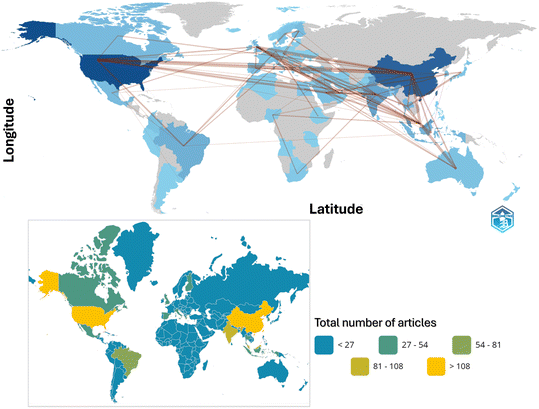 | ||
| Fig. 9 Social structure: countries' collaboration map. The red line's thickness indicates the collaboration frequency (inset figure: choropleth global map of published articles distribution). | ||
The bibliometrix analysis allows for the examination of international collaboration by measuring the number of publications authored within a single country compared to those co-authored by researchers from different countries. Accordingly, articles can be classified into two categories: single-country publications (SCP), where all authors are from the same country, indicating domestic collaboration, and multiple-country publications (MCP), where authors represent different countries, reflecting international collaboration. Each country has its own SCP and MCP values as depicted in Fig. 10. Although both the USA and China have produced a substantial number of articles on the topic, there are notable differences between the two countries regarding SCP and MCP. Our bibliometrix analysis revealed that the proportion of MCP is higher in the USA (MCP ratio of 0.152) than in China (MCP ratio of 0.146). Conversely, the USA has a lower SCP ratio compared to China, suggesting that American research tends to be more collaborative internationally. Meanwhile, Egypt has an MCP ratio of zero, indicating that its publications are solely produced without collaboration with researchers from other countries. Nonetheless, the United Kingdom has the highest MCP ratio (0.667) among the most productive countries, indicating that it has the most collaborative work on the related topic. Based on this analysis, it is clear that most publications are still created through domestic collaborations. This finding suggests that there is potential for collaboration with researchers from other countries to increase publication productivity.
As a result of these collaborations, bibliometrix analysis produced the most cited country categories as depicted in Fig. 11. The USA ranks first in citations (12529) and China ranks second (5572). Additionally, sponsorship funding aids in boosting the number of publications within a country. As a result of the funding opportunities that are accessible, scientists are incentivized to conduct targeted research and generate publications. Some forms of active financing in the most productive countries are detailed in Table 4. Statistical data indicates that countries with high publication output do not consistently receive complete sponsorship support. This can be achieved by conducting the research with autonomous funding, ensuring that it is not influenced by the financial support of a specific organization. Numerous funding sources demonstrate that green diesel research is an extremely fascinating topic with lots of yet to be explored for novel findings.
| Country | Funding sponsor | TP |
|---|---|---|
| a TP = total publications. | ||
| USA | National Science Foundation; U.S. Department of Energy; and local institutions | 298 |
| China | National Natural Science Foundation of China; National Key Research and Development Program of China; and local institutions | 250 |
| Malaysia | Ministry of Higher Education; and local institutions | 112 |
| India | Council of Scientific and Industrial Research India; Department of Science and Technology, Ministry of Science and Technology, India; and local university | 93 |
| Brazil | Conselho Nacional de Desenvolvimento Científico e Tecnológico; Coordenação de Aperfeiçoamento de Pessoal de Nível Superior; and local institutions | 67 |
| Indonesia | Ministry of Education, Research, Culture, and Technology, National Research and Innovation Agency, and local institutions | 54 |
| Thailand | Thailand Research Fund; National Nanotechnology Center; National Science and Technology Development Agency; and local institutions | 48 |
| UK | Engineering and Physical Sciences Research Council; Petroleum Technology Development Fund; British Council; and local institutions | 48 |
| Canada | Natural Sciences and Engineering Research Council of Canada; Canada Research Chairs; BioFuelNet Canada; Mitacs; Alberta Innovates | 43 |
| Finlandia | Horizon 2020 Framework Programme; Business Finland; Agricultural Research Service; European Commission; and local institutions | 42 |
| Greece | General Secretariat for Research and Technology; Hellenic Foundation for Research and Innovation; and local institutions | 42 |
| Published year | TC; FWCI | Author | Title | Source | Main point |
|---|---|---|---|---|---|
| a TC = total citations; FWCI = field-weighted citation impact. | |||||
| 2010 | 797 | Knothe G.111 | Biodiesel and renewable diesel: a comparison | Progress in energy and combustion science | Transesterification of oil or fat with methanol under mild circumstances with a base catalyst produces biodiesel. Lipid feedstocks can also produce diesel-like fuel. This “renewable diesel” is made from fat or oil via hydrodeoxygenation at high temperature and pressure using a catalyst |
| 8.83 | |||||
| 2009 | 367 | Donnis et al.112 | Hydroprocessing of bio-oils and oxygenates to hydrocarbons. Understanding the reaction routes | Topics in catalysis | Rapeseed oil converted completely into linear alkanes at modest hydrotreating settings in feed testing. The relative rates of HDO and decarboxylation were computed from gas and liquid yields and matched the observed distribution of n-C17/n-C18 and n-C21/n-C22. Hydrotreating is a reliable and versatile method |
| 5.38 | |||||
| 2012 | 285 | Veriansyah et al.113 | Production of renewable diesel by hydroprocessing of soybean oil: effect of catalysts | Fuel | The effects of various supported catalysts on the hydroprocessing of soybean oil were investigated, with performance measured at a catalyst/oil weight ratio of 0.044. The results showed the following order of effectiveness: sulfided NiMo/γ-Al2O3 (92.9%) > 4.29 wt% Pd/γ-Al2O3 (91.9%) > sulfided CoMo/γ-Al2O3 (78.9%) > 57.6 wt% Ni/SiO2–Al2O3 (60.8%) > 4.95 wt% Pt/γ-Al2O3 (50.8%) > 3.06 wt% Ru/Al2O3 (39.7%). When Ni or Pd catalysts were used, the liquid product was primarily composed of straight-chain n-C17 and n-C15 alkanes. The CoMo catalyst, due to its higher isomerization and cracking activity, was capable of producing lighter and isomerized hydrocarbons. The predominant reaction pathway with the Pd catalyst was decarboxylation, whereas hydrodeoxygenation (HDO) was favored when using NiMo or CoMo catalysts |
| 8.96 | |||||
| 2010 | 278 | Shonnard et al.114 | Camelina-derived jet fuel and diesel: sustainable advanced biofuels | Environmental progress & sustainable energy | A commercial airline conducted tests on isoparaffin-rich jet fuel derived from camelina, a low-input, non-food oilseed crop. The greenhouse gas (GHG) life cycle emissions for green diesel (GD) and hydrotreated renewable jet (HRJ) fuel were measured at 18.0 and 22.4 g CO2 equiv. per MJ, respectively, resulting in GHG reductions of 80% and 75% compared to conventional petroleum fuels. Scenario evaluations considered factors such as allocation mechanisms, nitrogen fertilizer application rates, N2O emission factors, hydrogen sources, and farm diesel consumption to account for model assumptions and data uncertainties |
| 5.35 | |||||
| 2009 | 251 | Aatola et al.115 | Hydrotreated vegetable oil (HVO) as a renewable diesel fuel: trade-off between NOx, particulate emission, and fuel consumption of a heavy duty engine | SAE International journal of engines | Hydrotreated vegetable oils (HVO) offer several advantages over ester-type biodiesel fuels, as they do not cause issues such as increased NOx emissions, deposit formation, storage instability, accelerated engine oil degradation, or poor cold-weather performance. HVOs consist of high-cetane, straight-chain paraffinic hydrocarbons that are free of aromatics, oxygen, and sulfur. The study tested sulfur-free diesel, pure HVO, and a blend of 30% HVO with 70% diesel, suggesting that engine settings and fuel composition can be optimized to improve performance |
| 7.58 | |||||
| 2016 | 224 | Patel & Kumar116 | Production of renewable diesel through the hydroprocessing of lignocellulosic biomass-derived bio-oil: a review | Renewable and sustainable energy reviews | A sulfided NiMo/CoMo catalyst supported on γ-Al2O3 is commonly used as a reference catalyst for hydrodeoxygenation (HDO) in renewable diesel production and serves as a benchmark for hydrodesulfurization reactions. The hydroprocessed renewable diesel shares similar characteristics with conventional petro-diesel. This review paper primarily focuses on the limitations of hydroprocessing technology, key process parameters, and the reaction mechanisms involved in the upgrading of bio-oil |
| 2.04 | |||||
The first highly cited publication, “A process model to estimate biodiesel production costs” by Haas et al.117 gives a detailed process model for calculating the capital and production costs of a biodiesel production facility. The study focuses on the synthesis of fuel-grade biodiesel from soybean oil and emphasizes the need to input current best values for reagent, equipment, and supplier prices into the model. The model takes into account current reagent and equipment costs, process simulation software, and waste stream disposal. It emphasizes the use of reliable data and economic research in biodiesel manufacturing. The study emphasizes the promise of biodiesel as a renewable fuel with lower emissions and comparable performance to conventional diesel. The second highly cited work, “Techno-economic analysis of autotrophic microalgae for fuel production” by Davis et al.118 emphasizes the potential of autotrophic microalgae to dramatically impact the US fuel market. The study examines open pond and photobioreactor systems, assessing their water consumption, CO2 and nutrient requirements, land footprint, and electricity balance. The research defines baseline economics for algal biofuel production and emphasizes the importance of strain improvements in cost reduction. The third highly cited article written by Knothe et al.111 examines biodiesel and renewable diesel as alternative fuels sourced from lipid feedstocks like fats and oils. Transesterification produces biodiesel, whereas hydrodeoxygenation yields renewable diesel. The comparison considers fuel production, energy balance, characteristics, environmental impact, and co-products. The study examines the rivalry or complementarity between various fuels, as well as the problems and opportunities associated with their production and consumption.
Field-weighted citation impact (FWCI) compares the frequency of citations for a given document to that of its peers. A value exceeding 1.00 signifies that the document has received a greater number of citations than anticipated according to the mean. The criteria for evaluation include the publication year, document type, and the disciplines associated with the source. Table 5 shows that all articles with the highest citations have very high FWCI values regarding the linearity and relevance of the selected topics.119,120
4.2. Knowledge structures
The resulting maps with clustered structures are sized based on the characteristics of links (L) and total link strength (TLS). These dimensions indicate the number of connections an item has with other items and the overall strength of those connections. The yellow color represents a main theme and the most frequently used cluster code, with green diesel, triglycerides, hydrotreatment, catalytic cracking, and bio-hydrogenated diesel become its representative phrases, indicating the greatest urgency in the related topic's study aspect. The map also displays the keyword nickel, cobalt, palladium, platinum and SBA-15, activated carbon, zeolites as types of catalyst and support that are extensively employed in green diesel production-related reactions. Additionally, the terms of feedstocks such as vegetable oil, FAME, oleic acid, jatropha oils are noted in yellow and orange color. The red code is accountable for the second-largest cluster, which includes renewable diesel as an alternative term for green diesel. The appearance of several processes in fuel production reactions is also observed, such as combustion, hydro-processed. Several terms associated with the evaluation parameters of the produced fuel are also included, such as life cycle assessment or analysis, techno-economic assessment or analysis, sustainability, and greenhouse gas emissions. The other colors (green, purple, pink, brown clusters) contain the terms that resulted from the previous clusters' interactions.
As confirmed by the biblioshiny interface, the top 5 most frequent words are diesel engines (300 occurrences), biodiesel (281 occurrences), biofuels (218 occurrences), renewable diesel (196 occurrences), and green diesel (177 occurrences). Research related to green diesel production is mainly carried out through the deoxygenation reaction of biomass waste and model compounds. Many types of catalyst development are carried out in line with efforts to increase the performance of targeted products. The DO reaction is an energy-intensive process, so the use of catalysts is required following green chemistry principles to reduce energy requirements.54 The ideal catalyst for this process should produce green diesel with a high cetane number and low coke formation.56 The development of catalysts with good chemical stability, superior catalyst activity, and high hydrocarbon selectivity over the diesel range is essential for the effectiveness of DO reaction.57
In a more in-depth examination of the terms and words used in publications, Fig. 13 illustrates the significance of the most commonly used words. This analysis makes use of bibliometric techniques to identify important terms, phrases, or concepts found in a set of academic publications. Scholars examine keywords, co-occurrence patterns, and correlations to reveal prevailing themes, developing patterns, and crucial subjects within a discipline. Making sense of the fundamental concepts, relationships, and development of research is made easier with the support of this analysis, which benefits scholars, decision-makers, and interested parties. According to the findings, terms with high relevance appear frequently in publications such as diesel engines, biodiesel, and biofuels. The frequency with which specific terms appear in publications is a factor that can be compared on an annual basis. Fig. 14 visualizes the frequency of the primary terms associated with the subject under consideration. Biodiesel and biofuel emerged as the two most frequently used terms between 2012 and 2020. Following that period (2021–2022), additional research on diesel engines was conducted as a result of the term diesel engines appearing more frequently than biofuels. By 2023, the frequency of diesel engine terms may surpass that of biodiesel terms. This opens the door for future research to shift its focus from the development of manufacturing processes to the use of renewable fuels.
To investigate the popularity of words over time, we conduct an analysis on a topic that is currently gaining significant attention. This analysis is a systematic approach to studying the progression and impact of literary concepts on the field over time. Based on the analysis of Fig. 16, it can be deduced that the subjects that have received considerable focus in recent times are illustrated on the right side of the figure. This was achieved through the examination of the interconnected words or topics and the assessment of their importance and concentration within the network. The keywords ignition delays, rapeseed oil, flash points, esterification, petroleum, and jatropha were popular in the past, while the keywords catalysts, biofuels, biodiesel, hydrodeoxygenation, fatty acids, renewable diesels, catalysts activity, jet fuel, and green diesels have been more widely used in recent years. Fig. 16 reveals the identification of trends in research topics related to green diesel, which in turn provides insights into the current research directions. The identification process yields the following designations for bio-jet fuel, catalyst, isomerization, thermal efficiency, and polymerization.
Fig. 16 thus effectively captures the transition in research interests and the emergence of new trends within the domain of green diesel. This trend analysis not only pinpoints prevailing research themes but also provides valuable insights into the current directions of scientific inquiry. For instance, the identification process highlights critical areas of development such as bio-jet fuel production, advancements in catalytic processes, isomerization techniques, improvements in thermal efficiency, and polymerization methods. These insights help to elucidate the evolving research landscape, allowing for strategic alignment of future studies with emerging areas of interest.
Thematic mapping was used to uncover the conceptual framework of the literature to identify the primary research themes in green diesel research. This analysis yields a collection of themes organized in a two-dimensional space based on their centrality (x-axis) and density (y-axis). Fig. 17 presents a thematic map consisting of four topic quadrants. These results were generated using a semi-automatic method that analyzes the titles of all referenced research objects and incorporates additional relevant keywords beyond those provided by the authors, leading to more diverse outcomes.22 The upper left quadrant, characterized by its high density, contains a distinct and well-developed research pattern. However, it lacks centrality, indicating the absence of a clear and dominant theme. This quadrant includes topics such as lipid and hydro-processed renewable diesel, suggesting that research in this area remains relatively broad and varied. In contrast, the upper right quadrant, marked by both high density and centrality, has been identified as a high-priority area. It encompasses motor themes that are highly interconnected and foundational to the field's structure. These well-developed themes are represented by keywords that frequently co-occur, reflecting their significance within the research network.22 Green diesel, deoxygenation, hydrodeoxygenation, emissions, HVO (hydrotreated vegetable oil), and diesel engine are included in upper-right quadrant. As a result, further research in this area is recommended. The lower left quadrant is characterized by topics that have been extensively studied over time but are currently declining in popularity, as indicated by their low centrality. This quadrant includes the topic of aldol condensation, lignocellulose, and furfural. The lower right quadrant, on the other hand, contains core themes with low density and strong centrality. It consists of several terms such as bio-jet fuel, life cycle assessment, biomass. Future studies must be able to contribute meaningfully to the existing body of knowledge, address gaps, and provide novelty findings in terms of renewable diesel, biodiesel, and bio-jet fuel. Table 6 summarizes research gap, current development, and future outlooks related to these findings.
| Key research gap | Current development/challenges | Future outlooks |
|---|---|---|
| Feedstock sources | Current feedstocks, such as vegetable oils and animal fats, face competition with food production, leading to ethical and sustainability concerns | Feedstock diversification: expanding to second-generation feedstocks lik waste oil (e.g. used cooking oil), and non-edible crops like jatropha; and third-generation feedstocks like microalgae and other advanced sources offer high yields but are still in early development stages and have scalability challenges |
| Price | • Green diesel production still depends on hydrogen derived from fossil fuel | • The development of non-noble metal catalysts, as well as research into bio-catalysts and recyclable catalysts, presents promising avenues for reducing production costs while maintaining high efficiency |
| • Prices are heavily influenced by the availability and cost of feedstock (e.g., vegetable oils, animal fats) and hydrogen sources (green vs. fossil-derived hydrogen) | • The integration of green hydrogen, derived from renewable sources, can further enhance the sustainability of the reaction process | |
| Catalyst | • Catalyst deactivation occurs due to impurities in the feedstock (e.g., sulfur, phosphorus), leading to metal poisoning and carbon deposition that shorten catalyst lifespan and require frequent regeneration or replacement | • Researchers are focusing on developing robust catalysts that can handle impurities more effectively, improving their lifespan and reducing downtime for regeneration |
| • Lower-quality, inexpensive feedstocks like waste or non-edible oils are cost-effective but often contain contaminants that damage catalysts | • Research targeting feedstock-flexible catalysts that can process a wide range of feedstocks, including those with higher impurity levels. Bi-functional catalysts that can both treat impurities and support the deoxygenation process could allow for the wider use of cheaper, low-quality feedstocks, making the entire process more sustainable and cost-effective | |
| • Many existing catalysts lack selectivity, resulting in undesired by-products and process inefficiencies | • Advancements in catalyst design, particularly in the field of nano-catalysis and catalyst surface engineering, could lead to more selective catalysts | |
| Policy and regulations | Different countries align their green diesel strategies with broader energy and economic policies, but varying regulations between developed and developing nations hinder global scale-up. While developed countries enforce strict carbon reduction targets and green fuel incentives, developing nations focus on economic growth and affordable energy | • Harmonizing global policies, especially around carbon pricing and emission trading |
| • Establishing international certifications for sustainable biofuels which could ease trade and create larger markets for green diesel | ||
| • Global standards are required for certifying the sustainability of biofuels, creating market barriers and slowing the adoption of green diesel in international trade |
5 Conclusions
This study provides the first bibliometric review related to green diesel, renewable diesel, or bio-jet production based on literature data from the Scopus database published during 1989 until October 2024 by using a bibliometric method and software tools, namely: VOSviewer and RStudio (bibliometrix). The analyzed documents yielded a comprehensive overview of the performance of contributors, research trends, and research topics related to green diesel. The results showed that the number of articles inclined during the research period into three stages: (i) initiation (stagnant number of articles during 1989–2006); (ii) exploration (article published increased significantly from 2007 to 2012); (iii) elevation (dramatic incline in the number of articles from 2013 until today). The USA, China, Malaysia, India and Brazil are the top five countries contributed the greatest number of published documents to the related studies. Since 2012, Dalian Institute of Chemical Physics has published the most academic paper, then surpassed by the University Putra Malaysia in 2022. Globally, research institutions collaborated with one another, however these collaborations are comparatively dispersed throughout the world: USA-China, China-Malaysia and Malaysia-Australia. In addition to that, the main research keywords were summarised. Studies related to diesel engines, biodiesel, biofuels, renewable diesel and green diesel are the hot research topics with deoxygenation as the main reaction involve in the production of green diesel.In this study, the research trends and current situation of green diesel were analysed. The results reveal that significant progress has been made in the development of catalyst for deoxygenation reactions of green diesel. Nevertheless, this bibliometric analysis suggests focusing on enhancing the efficiency of green diesel production to achieve commercialization goals and facilitate its use as jet fuel for future research. However, there are still some research gaps on the utilization of biomass in the catalytic production of green diesel with the ultimate objective of mitigating greenhouse gas emissions. Carbon emissions can be drastically reduced through the use of green diesel as a sustainable fuel. Additionally, by enhancing the quality of commercial biodiesel, the development of renewable resource methods enables green diesel production. Each of these points fulfils SDG 7, which pertains to affordable and clean energy. Research on green diesel applications aligns with SDG 13, as it supports green economy targets and environmental protection, and addresses global warming as the primary driver of climate change. Therefore, by achieving the globally important SDGs mission, this area of study aids in promoting sustainable development through the use of renewable energy technology. This paper offers comprehensive data reference for future scholar grasp the trajectory of the research in the field of green diesel.
Data availability
This study was carried out using publicly available data from Scopus database at https://www.scopus.com/ with specific keywords.Author contributions
Conceptualization: Zeni Rahmawati, Hamzah Fansuri. Supervision: Hamzah Fansuri. Methodology: Jeesica Hermayanti Pratama. Resources: Jeesica Hermayanti Pratama. Funding acquisition: Hamzah Fansuri. Writing – original draft: Jeesica Hermayanti Pratama, Zeni Rahmawati. Visualization: Jeesica Hermayanti Pratama. Writing – review and editing: Alvin Rahmad Widyanto, Triyanda Gunawan, Wan Nazwanie Wan Abdullah, Nor Laili Azua Jamari, Afan Hamzah, Hamzah Fansuri.Conflicts of interest
There are no conflicts to declare.Acknowledgements
The authors gratefully acknowledge the Ministry of Education, Culture, Research, and Technology of the Republic of Indonesia (Kemendikbudristek) for providing the research grant through National Competitive Basic Research/Penelitian Dasar Kompetitif Nasional (PDKN) scheme (Decree Number 0162/E5.4/DT.05.00/2023, and Master Agreement/Contract Number 009/E5/PG.02.00. PL/2023 dated 12 April 2023, and Derivative Agreement/Contract Number 1192/PKS/ITS/2023 dated 13 April 2023). The first author, Jeesica Hermayanti Pratama, also acknowledges the Indonesian Endowment Fund for Education (LPDP), Ministry of Finance of the Republic of Indonesia, for supporting her studentship at ITS.Notes and references
- A. Sonthalia and N. Kumar, J. Energy Inst., 2019, 92, 1–17 CrossRef.
- A. Amin, Ain Shams Eng. J., 2019, 10, 821–839 CrossRef.
- C. A. Scaldaferri and V. M. D. Pasa, Renewable Sustainable Energy Rev., 2019, 111, 303–313 CrossRef.
- E. Kordouli, B. Pawelec, K. Bourikas, C. Kordulis, J. L. G. Fierro and A. Lycourghiotis, Appl. Catal., B, 2018, 229, 139–154 CrossRef.
- L. M. Orozco, D. A. Echeverri, L. Sánchez and L. A. Rios, Chem. Eng. J., 2017, 322, 149–156 CrossRef.
- K. W. Cheah, S. Yusup, A. C. M. Loy, B. S. How, V. Skoulou and M. J. Taylor, Mol. Catal., 2022, 523, 111469 CrossRef.
- P. Hellier, M. Talibi, A. Eveleigh and N. Ladommatos, Proc. Inst. Mech. Eng., Part D, 2018, 232(1), 90–105 CrossRef.
- Z. Cai, R. Liang, P. Yu, Y. Liu, Y. Ma, Y. Cao, K. Huang, L. Jiang and X. Bao, Fuel Process. Technol., 2022, 226, 107091 CrossRef.
- H. I. Mahdi, A. Bazargan, G. McKay, N. I. W. Azelee and L. Meili, Chem. Eng. Res. Des., 2021, 174, 158–187 CrossRef.
- J. Zafeiropoulos, G. Petropoulos, E. Kordouli, C. Kordulis, A. Lycourghiotis and K. Bourikas, Catal. Today, 2023, 423, 113952 CrossRef.
- T. K. Vo, W.-S. Kim, S.-S. Kim, K. S. Yoo and J. Kim, Energy Convers. Manage., 2018, 158, 92–102 CrossRef.
- R. Raman, V. K. Nair, V. Prakash, A. Patwardhan and P. Nedungadi, Energy Rep., 2022, 8, 9242–9260 CrossRef.
- A. Sridhar, M. Ponnuchamy, P. Senthil Kumar, A. Kapoor and L. Xiao, Int. J. Hydrogen Energy, 2022, 47(62), 26326–26354 CrossRef.
- L. da S. Dutra, M. Costa Cerqueira Pinto, E. P. Cipolatti, E. C. G. Aguieiras, E. A. Manoel, J. Greco-Duarte, D. M. Guimarães Freire and J. C. Pinto, Renewable Sustainable Energy Rev., 2022, 153, 111765 CrossRef.
- C. Chen, A. Chitose, M. Kusadokoro, H. Nie, W. Xu, F. Yang and S. Yang, Energy Rep., 2021, 7, 4022–4034 CrossRef.
- P. Andreo-Martínez, V. M. Ortiz-Martínez, N. García-Martínez, A. P. de los Ríos, F. J. Hernández-Fernández and J. Quesada-Medina, Appl. Energy, 2020, 264, 114753 CrossRef.
- M. Hasan, M. Z. Abedin, M. Bin Amin, Md. Nekmahmud and J. Oláh, J. Environ. Manage., 2023, 336, 117644 CrossRef PubMed.
- N. Donthu, S. Kumar, D. Mukherjee, N. Pandey and W. M. Lim, J. Bus. Res., 2021, 133, 285–296 CrossRef.
- W. Chen, W. Liu, Y. Geng, M. T. Brown, C. Gao and R. Wu, Renewable Sustainable Energy Rev., 2017, 73, 1051–1060 CrossRef.
- M. K. Linnenluecke, M. Marrone and A. K. Singh, Aust. J. Manag., 2020, 45, 175–194 CrossRef.
- M. J. Cobo, A. G. López-Herrera, E. Herrera-Viedma and F. Herrera, J. Am. Soc. Inf. Sci. Technol., 2011, 62, 1382–1402 CrossRef.
- M. Aria and C. Cuccurullo, J. Informetr., 2017, 11, 959–975 CrossRef.
- W. Wei and Z. Jiang, Heliyon, 2023, 9, e16839 CrossRef.
- D. Kubička, J. Horáček, M. Setnička, R. Bulánek, A. Zukal and I. Kubičková, Appl. Catal., B, 2014, 145, 101–107 CrossRef.
- A. A. Alimin and B. H. Susanto, E3S Web Conf., 2018, 67, 02022 CrossRef CAS.
- D. C. Makepa, C. H. Chihobo and D. Musademba, Heliyon, 2023, 9, e22261 CrossRef CAS PubMed.
- Pertamina, Successfully Creates Bioavtur J2.4, Pertamina Supports National Clean Energy Strategic Program Search PubMed.
- S. L. Douvartzides, N. D. Charisiou, K. N. Papageridis and M. A. Goula, Energies, 2019, 12, 809 CrossRef CAS.
- L. Chen, H. Li, J. Fu, C. Miao, P. Lv and Z. Yuan, Catal. Today, 2016, 259, 266–276 CrossRef CAS.
- H. Xu, L. W. Ou, Y. Li, T. R. Hawkins and M. Wang, Environ. Sci. Technol., 2022, 56, 7512–7521 CrossRef CAS.
- W. C. Wang and C. H. Hsieh, Chem. Eng. Res. Des., 2020, 153, 63–74 CrossRef CAS.
- H. Jeong, M. Shin, B. Jeong, J. H. Jang, G. B. Han and Y. W. Suh, J. Ind. Eng. Chem., 2020, 83, 189–199 CrossRef CAS.
- S. Janampelli and S. Darbha, Mol. Catal., 2018, 451, 125–134 CrossRef CAS.
- L. Zhou, W. Lin, K. Liu, Z. Wang, Q. Liu, H. Cheng, C. Zhang, M. Arai and F. Zhao, Catal. Sci. Technol., 2020, 10, 222–230 RSC.
- Y. Zhou, L. Liu, G. Li and C. Hu, ACS Catal., 2021, 11, 7099–7113 CrossRef CAS.
- A. Srifa, K. Faungnawakij, V. Itthibenchapong and S. Assabumrungrat, Chem. Eng. J., 2015, 278, 249–258 CrossRef CAS.
- N. Asikin-Mijan, G. AbdulKareem-Alsultan, M. S. Mastuli, A. Salmiaton, M. Azuwa Mohamed, H. V. Lee and Y. H. Taufiq-Yap, Fuel, 2022, 325, 124917 CrossRef CAS.
- M. Ameen, M. T. Azizan, A. Ramli, S. Yusup and B. Abdullah, Catal. Today, 2020, 355, 51–64 CrossRef CAS.
- X. Li, Y. Wu, Q. Wang, S. Li, Y. Ye, D. Wang and Z. Zheng, Renewable Energy, 2022, 193, 1–12 CrossRef CAS.
- D. Singh, K. A. Subramanian and S. K. Singal, Appl. Energy, 2015, 155, 440–446 CrossRef CAS.
- L. Fu, Z. Liu, X. Li, Y. Li, H. Yang and Y. Liu, Fuel, 2022, 322, 124027 CrossRef CAS.
- S. Thongkumkoon, W. Kiatkittipong, U. W. Hartley, N. Laosiripojana and P. Daorattanachai, Renewable Energy, 2019, 140, 111–123 CrossRef CAS.
- M. S. Gamal, N. Asikin-Mijan, W. N. A. W. Khalit, M. Arumugam, S. M. Izham and Y. H. Taufiq-Yap, Fuel Process. Technol., 2020, 208, 106519 CrossRef CAS.
- Z. Rahmawati, L. Santoso, A. McCue, N. L. Azua Jamari, S. Y. Ninglasari, T. Gunawan and H. Fansuri, RSC Adv., 2023, 13, 13698–13714 RSC.
- N. A. Abdul Razak, N.-A. Mijan, Y. H. Taufiq-Yap and D. Derawi, J. Cleaner Prod., 2022, 366, 132971 CrossRef CAS.
- A. A. F. da Costa, L. H. d O. Pires, D. R. Padrón, A. M. Balu, G. N. da Rocha Filho, R. Luque and L. A. S. do Nascimento, Mol. Catal., 2022, 518, 112052 CrossRef CAS.
- J. E. Lam, A. R. Mohamed, A. N. Kay Lup and M. K. Koh, Fuel Process. Technol., 2022, 236, 107394 CrossRef CAS.
- M. Y. Choo, L. E. Oi, T. C. Ling, E. P. Ng, Y. C. Lin, G. Centi and J. C. Juan, J. Anal. Appl. Pyrolysis, 2020, 147, 104797 CrossRef CAS.
- S. Lucantonio, A. Di Giuliano, L. Rossi and K. Gallucci, Energies, 2023, 16(2), 1–44 CrossRef.
- D. Valencia, I. García-Cruz, V. H. Uc, L. F. Ramírez-Verduzco, M. A. Amezcua-Allieri and J. Aburto, Biomass Bioenergy, 2018, 112, 37–44 CrossRef CAS.
- N. Hongloi, P. Prapainainar and C. Prapainainar, Mol. Catal., 2022, 523, 111696 CrossRef CAS.
- R. X. Chen and W. C. Wang, Renewable Energy, 2019, 135, 819–835 CrossRef CAS.
- J. K. Lin, C. P. Lee, H. P. Lin, E. Halim and W. C. Wang, Int. J. Energy Res., 2021, 45, 19043–19061 CrossRef CAS.
- K. Kakaei, M. D. Esrafili and A. Ehsani, Interface Sci. Technol., 2019, 27, 1–21 Search PubMed.
- I. M. Rizwanul Fattah, H. C. Ong, T. M. I. I. Mahlia, M. Mofijur, A. S. Silitonga, S. M. A. Rahman and A. Ahmad, Front. Energy Res., 2020, 8, 1–39 CrossRef.
- R. S. R. M. Hafriz, I. N. Shafizah, N. A. Arifin, A. Salmiaton, R. Yunus, Y. H. T. Yap and A. H. Shamsuddin, Renewable Energy, 2021, 178, 128–143 CrossRef CAS.
- X. Y. Ooi, W. Gao, H. C. Ong, H. V. Lee, J. C. Juan, W. H. Chen and K. T. Lee, Renewable Sustainable Energy Rev., 2019, 112, 834–852 CrossRef CAS.
- X. Yao, T. J. Strathmann, Y. Li, L. E. Cronmiller, H. Ma and J. Zhang, Green Chem., 2021, 23, 1114–1129 RSC.
- S. Cheng, L. Wei, J. Julson and M. Rabnawaz, Energy Convers. Manage., 2017, 150, 331–342 CrossRef CAS.
- N. Hongloi, P. Prapainainar, A. Seubsai, K. Sudsakorn and C. Prapainainar, Energy, 2019, 182, 306–320 CrossRef CAS.
- S. R. Chia, S. Nomanbhay, M. Y. Ong, K. W. Chew, K. S. Khoo, H. Karimi-Maleh and P. L. Show, Front. Energy Res., 2021, 9, 1–7 Search PubMed.
- A. Bjelić, M. Grilc, M. Huš and B. Likozar, Chem. Eng. J., 2019, 359, 305–320 CrossRef.
- I. Edeh, T. Overton and S. Bowra, Biofuels, 2021, 12, 945–952 CrossRef CAS.
- S. Xie, C. Jia, A. Prakash, M. I. Palafox, J. Pfaendtner and H. Lin, ACS Catal., 2019, 9, 3753–3763 CrossRef CAS.
- I. Vázquez-Garrido, A. López-Benítez, A. Guevara-Lara and G. Berhault, Catal. Today, 2021, 365, 327–340 CrossRef.
- N. Aliana-Nasharuddin, N. Asikin-Mijan, G. Abdulkareem-Alsultan, M. I. Saiman, F. A. Alharthi, A. A. Alghamdi and Y. H. Taufiq-Yap, RSC Adv., 2020, 10, 626–642 RSC.
- N. Srihanun, P. Dujjanutat, P. Muanruksa and P. Kaewkannetra, Catalysts, 2020, 10, 1–13 CrossRef.
- S. Janampelli and S. Darbha, Catal. Commun., 2019, 125, 70–76 CrossRef CAS.
- C. S. Smoljan, J. M. Crawford and M. A. Carreon, Catal. Commun., 2020, 143, 106046 CrossRef CAS.
- K. Vasić, G. H. Podrepšek, Ž. Knez and M. Leitgeb, Catalysts, 2020, 10(2), 1–20 CrossRef.
- S. Phimsen, W. Kiatkittipong, H. Yamada, T. Tagawa, K. Kiatkittipong, N. Laosiripojana and S. Assabumrungrat, Energy Convers. Manage., 2017, 151, 324–333 CrossRef CAS.
- F. Wang, J. Xu, J. Jiang, P. Liu, F. Li, J. Ye and M. Zhou, Fuel, 2018, 216, 738–746 CrossRef CAS.
- D. Kubička and L. Kaluža, Appl. Catal., A, 2010, 372, 199–208 CrossRef.
- P. Arora, H. Ojagh, J. Woo, E. Lind Grennfelt, L. Olsson and D. Creaser, Appl. Catal., B, 2018, 227, 240–251 CrossRef CAS.
- J. Horáček, U. Akhmetzyanova, L. Skuhrovcová, Z. Tišler and H. de Paz Carmona, Appl. Catal., B, 2020, 263, 118328 CrossRef.
- H. De Paz Carmona, J. Horáček, Z. Tišler and U. Akhmetzyanova, Fuel, 2019, 254, 115582 CrossRef CAS.
- S. K. Kim, J. Kim and S. C. Lee, Catal. Commun., 2017, 99, 61–65 CrossRef CAS.
- N. Krobkrong, V. Itthibenchapong, P. Khongpracha and K. Faungnawakij, Energy Convers. Manage., 2018, 167, 1–8 CrossRef CAS.
- M. Safa Gamal, N. Asikin-Mijan, M. Arumugam, U. Rashid and Y. H. Taufiq-Yap, J. Anal. Appl. Pyrolysis, 2019, 144, 104690 CrossRef CAS.
- K. W. Cheah, M. J. Taylor, A. Osatiashtiani, S. K. Beaumont, D. J. Nowakowski, S. Yusup, A. V. Bridgwater and G. Kyriakou, Catal. Today, 2020, 355, 882–892 CrossRef CAS.
- K. Zhou, X. Du, L. Zhou, H. Yang, X. Lei, Y. Zeng, D. Li and C. Hu, Catalysts, 2021, 11, 469 CrossRef CAS.
- F. Wang, J. Jiang, K. Wang, Q. Zhai, H. Sun, P. Liu, J. Feng, H. Xia, J. Ye, Z. Li, F. Li and J. Xu, Fuel, 2018, 228, 103–111 CrossRef CAS.
- M. Liu, Y. Shi, K. Wu, J. Liang, Y. Wu, S. Huang and M. Yang, Catal. Commun., 2019, 129, 105726 CrossRef CAS.
- J. D. D. Moreira, D. B. de Rezende, V. M. D. Pasa, J. de Barros Dias Moreira, D. Bastos de Rezende and V. Márcia Duarte Pasa, Fuel, 2020, 269, 117253 CrossRef.
- M. Pratiwi, O. Muraza, G. F. Neonufa, R. Purwadi, T. Prakoso and T. H. Soerawidjaja, Energy Fuels, 2019, 33, 11648–11654 Search PubMed.
- S. N. Zdainal Abidin, H. V. Lee, N. Asikin-Mijan, J. C. Juan, N. A. Rahman, M. S. Mastuli, Y. H. Taufiq-Yap and P. S. Kong, Pure Appl. Chem., 2020, 92, 587–600 CrossRef CAS.
- A. Bustinza, M. Frías, Y. Liu and E. García-Bordejé, Catal. Sci. Technol., 2020, 10, 4061–4071 Search PubMed.
- M. K. Pasha, L. Dai, D. Liu, M. Guo and W. Du, Biotechnol. Biofuels, 2021, 14, 129 Search PubMed.
- Neste, NEXBTL technology Search PubMed.
- M. Y. Khan, R. L. Russell, W. A. Welch, D. R. Cocker and S. Ghosh, Energy Fuels, 2012, 26, 6137–6143 CrossRef CAS.
- F. Long, W. Liu, X. Jiang, Q. Zhai, X. Cao, J. Jiang and J. Xu, Renewable Sustainable Energy Rev., 2021, 148, 111269 CrossRef CAS.
- N. Arun, R. V. Sharma and A. K. Dalai, Renewable Sustainable Energy Rev., 2015, 48, 240–255 CrossRef CAS.
- A. Wong, in Annual Meeting - Technical Section, Canadian Pulp and Paper Association, Preprints, Publ by Canadian Pulp & Paper Association, Arbokem Inc, Vancouver, Canada, 1993, pp. A313–A318 Search PubMed.
- A. Shiehnejadhesar, K. Schulze, R. Scharler and I. Obernberger, Biomass Bioenergy, 2013, 53, 48–53 CrossRef CAS.
- W. Zhang and Y. Zhu, Energy Environ., 2014, 25, 93–104 Search PubMed.
- A. Demirbas, Energy Sources, Part A, 2007, 29, 549–561 CrossRef CAS.
- O. Marchenko, S. Solomin, V. Shamanskiy and I. Donskoy, Appl. Sci., 2022, 12, 1254 Search PubMed.
- S. Pattanayak, L. Hauchhum, C. Loha and L. Sailo, Biomass Convers. Biorefin., 2023, 13, 999–1011 CrossRef CAS.
- F. Jurado, M. Ortega, A. Cano and J. Carpio, Energy Sources, 2001, 23, 897–905 CrossRef CAS.
- J. Singh, S. Singh and S. K. Mohapatra, Energy Sources, Part A, 2020, 42, 41–55 CrossRef CAS.
- K. G. Morrissey, G. Thoma and D. E. López, Biotechnol. Biofuels, 2021, 14, 166 Search PubMed.
- V. Larnaudie, M. Bule, K.-Y. San, P. V. Vadlani, J. Mosby, S. Elangovan, M. Karanjikar and S. Spatari, Fuel, 2020, 279, 118429 CrossRef CAS.
- S. J. M. Algayyim, A. P. Wandel, T. Yusaf and I. Hamawand, Renewable Sustainable Energy Rev., 2018, 82, 1195–1214 CrossRef CAS.
- H. Kerras, R. Merouani, C. Nekkab, N. Outili and A. H. Meniai, 10th International Renewable Energy Congress (IREC), 2019, vol. 2019, pp. 1–5 Search PubMed.
- Y. Zhou, J. Remón, Z. Jiang, A. S. Matharu and C. Hu, Green Energy Environ., 2023, 8, 722–743 Search PubMed.
- X. Du, K. Zhou, L. Zhou, X. Lei, H. Yang, D. Li and C. Hu, J. Energy Chem., 2021, 61, 425–435 CrossRef CAS.
- S. C. Bradford, J. Inf. Sci., 1934, 10, 176–180 Search PubMed.
- Y. Ding, J.Informetr., 2011, 5(1), 187–203 CrossRef.
- E. Garfield and I. H. Sher, J. Am. Soc. Inf. Sci., 1993, 44, 298–299 Search PubMed.
- H. Karunathilake, T. Prabatha, R. Sadiq and K. Hewage, in Handbook of Energy and Environmental Security, Elsevier, 2022, pp. 61–88 Search PubMed.
- G. Knothe, Prog. Energy Combust. Sci., 2010, 36, 364–373 CrossRef CAS.
- B. Donnis, R. G. Egeberg, P. Blom and K. G. Knudsen, Top. Catal., 2009, 52, 229–240 CrossRef CAS.
- B. Veriansyah, J. Y. Han, S. K. Kim, S.-A. Hong, Y. J. Kim, J. S. Lim, Y.-W. Shu, S.-G. Oh and J. Kim, Fuel, 2012, 94, 578–585 CrossRef CAS.
- D. R. Shonnard, L. Williams and T. N. Kalnes, Environ. Prog. Sustainable Energy, 2010, 29, 382–392 CrossRef CAS.
- H. Aatola, M. Larmi, T. Sarjovaara and S. Mikkonen, SAE Int. J. Engines, 2008, 1(1), 1251–1262 CrossRef.
- M. Patel and A. Kumar, Renewable Sustainable Energy Rev., 2016, 58, 1293–1307 CrossRef CAS.
- M. J. Haas, A. J. McAloon, W. C. Yee and T. A. Foglia, Bioresour. Technol., 2006, 97, 671–678 CrossRef CAS.
- R. Davis, A. Aden and P. T. Pienkos, Appl. Energy, 2011, 88, 3524–3531 Search PubMed.
- L. Cai, J. Tian, J. Liu, X. Bai, I. Lee, X. Kong and F. Xia, Scientometrics, 2019, 118, 453–478 CrossRef.
- Y. Liu, Q. Wu, S. Wu and Y. Gao, Scientometrics, 2021, 126, 8653–8672 CrossRef.
- J. Sun, M.-H. Wang and Y.-S. Ho, Mar. Pollut. Bull., 2012, 64, 13–21 Search PubMed.
- N. Donthu, S. Kumar, D. Mukherjee, N. Pandey and W. M. Lim, J. Bus. Res., 2021, 133, 285–296 CrossRef.
| This journal is © The Royal Society of Chemistry 2024 |

